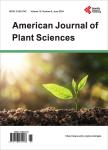Proteomics: A Successful Approach to Understand the Molecular Mechanism of Plant-Pathogen Interaction
Proteomics: A Successful Approach to Understand the Molecular Mechanism of Plant-Pathogen Interaction作者机构:Department of Biotechnology Visva-Bharati University Santiniketan India.
出 版 物:《American Journal of Plant Sciences》 (美国植物学期刊(英文))
年 卷 期:2013年第4卷第6期
页 面:1212-1226页
学科分类:1002[医学-临床医学] 100214[医学-肿瘤学] 10[医学]
主 题:Proteome Plant-Pathogen Interaction Systemic Acquired Resistance Mass Spectrometry Pathogenicity Related Proteins
摘 要:In recent years, proteomics has played a key role in identifying changes in protein levels in plant hosts upon infection by pathogenic organisms and in characterizing cellular and extracellular virulence and pathogenicity factors produced by pathogens. Proteomics offers a constantly evolving set of novel techniques to study all aspects of protein structure and function. Proteomics aims to find out the identity and amount of each and every protein present in a cell and actual function mediating specific cellular processes. Structural proteomics elucidates the development and application of experimental approaches to define the primary, secondary and tertiary structures of proteins, while functional proteomics refers to the development and application of global (proteome wide or system-wide) experimental approaches to assess protein function. A detail understanding of plant defense response using successful combination of proteomic techniques and other high throughput techniques of cell biology, biochemistry as well as genomics is needed for practical application to secure and stabilize yield of many crop plants. This review starts with a brief introduction to gel- and non gel-based proteomic techniques followed by the basics of plant-pathogen interaction, the use of proteomics in recent pasts to decipher the mysteries of plant-pathogen interaction, and ends with the future prospects of this technology.



